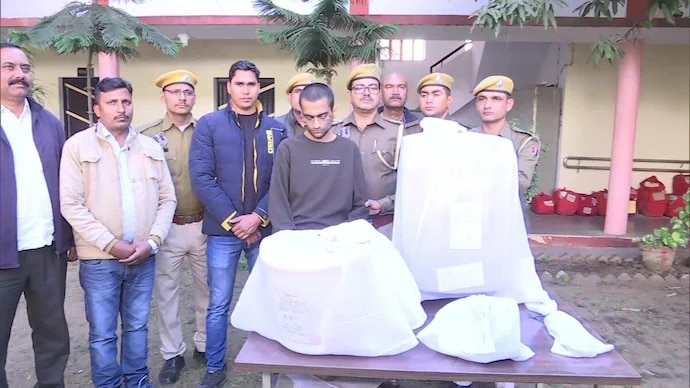How did the Shraddha Murder Case become a Copycat Murder template?

Between the arrest of Shraddha Walkar's killer Aaftab Poonawala and the recent murder from Najafgarh, several cases of dismembering and refrigerated body storage have come in the forefront (photo-DailyO)
Dubbed as “fridge murder” by the media circus that followed it, Shraddha Walkar’s murder by her live-in partner Aaftab Poonawala in 2022 definitely led to wide coverage of more such murders that involved dismembered bodies and refrigerated storage.
The recent case from Delhi’s Najafgarh that involved a man chopping up and storing his live-in partner’s remains in a fridge at his dhaba led the media to quickly draw parallels with Shraddha’s case.
Just a day after its coverage, another Shraddha-like case was reported, on February 15. This time, it was another man killing his live-in partner and stuffing her body (although not chopping it) in a mattress in Maharashtra’s Palghar.

Ever since Aaftab Poonawala was arrested last November and Shraddha’s murder (which happened in May 2022), many such cases started being reported on a national scale. Whether or not the accused in these cases used Shraddha’s case as a homicidal template, it is clear that the media coverage definitely boosted after Aaftab’s methods of killing Shraddha and storing her body became public knowledge.
But Aaftab himself might have been inspired by a Dehradun case...
More than a decade before Shraddha's murder, Dehradun local Rajesh Gulati was arrested for murdering his wife Anupama Gulati and dismembering her body into 72 pieces. Much like what Aaftab did with Shraddha's remains later, Rajesh too scattered Anupama's body parts in different parts of the Uttarakhand capital.

ALSO READ: 12 years before Shraddha murder case, Dehradun saw Anupama Gulati killed and chopped into 72 pieces
What's interesting is that Aaftab himself seemed to have Googled about this case after he killed his live-in partner. If the Anupama Gulati murder did actually inspire Aaftab (along with the TV series Dexter, an angle that received wide coverage), Aaftab himself was no less than a copycat murderer, inspiring several other copycat murders in the subsequent months.
Delhi, November 2022: A mother and son follow Aftab’s murder methods
Aping Aaftab’s methods of storing the body in a fridge and then scattering the body parts across the Mehrauli forest, a case was reported on November 28, 2022. This time around, a married woman killed her second husband with help from the second husband’s son from another marriage (quite a mouthful for a crime report).
READ MORE | Shraddha-like murder shocks East Delhi: Man's body chopped into 22 parts, stored in fridge
Pandav Nagar murder | Delhi: Visuals of the residence of the accused where they kept the chopped-off body pieces of the victim in the refrigerator. https://t.co/qRSsepJPzq pic.twitter.com/UVNalvLdT9
— ANI (@ANI) November 28, 2022
To break it down further, Poonam Das had married Anjan Das after the death of her first husband. But as it turned out, Anjan had another family with eight children (Deepak Das being one of the sons). Infuriated by what she considered an illicit affair, Poonam and Deepak collaborated to kill Anjan, chop his body, store the remains in a fridge, and then scatter it across different parts of Delhi.
Nov-Dec 2022: Similar cases from UP, West Bengal, Rajasthan
The month of November 2022 bore witness to similar dismembering incidents from Uttar Pradesh and West Bengal. In the former case, Azamgarh native Prince Yadav was angered by his longtime girlfriend Aradhna Prajapati marrying someone else. So, Prince and his cousin murdered her by strangulating her. They then proceeded to chop up the body into six pieces and throw them in a well outside the village.
In West Bengal’s Baruipur, former naval officer Ujjwal Chakraborty had a scuffle with his son that escalated to such an extent that the son pushed him back with his head hitting a chair. Ujjwal fell unconscious and the son hacked the body into five pieces. With help from his mother, he went on to scatter it across Baruipur only to confess to the murder himself a few days later.
West Bengal | Decomposed upper-body parts of a man were found wrapped in plastic in pond in Baruipur, South 24 Parganas dist. The deceased was identified as Ujjwal Chakraborty aged 55 yrs. He was an ex-navy non-commissioned officer who retired in 2000: Pushpa, SP, Baruipur(19.11) pic.twitter.com/6fOiSo9mn0
— ANI (@ANI) November 19, 2022
Last December was no exception, with Jaipur’s Anuj Sharma killing his widowed aunt, dividing her body into ten pieces with a marble-cutting machine, and dumping the remains in different parts of a forest towards the road to Delhi.

“Shraddha” has turned into a threat
Such has been the impact of Shraddha Walkar’s murder that the killing method and the victim’s name seems to have become a common threat. This month itself saw a case from Uttar Pradesh’s Etah district, when Shubham Rajput threatened to cut his wife into pieces like Shraddha after suspecting her of infidelity.
Much earlier, in November, a man named Mohammad Faiz was taken into custody in Kanpur when he allegedly threatened a 17-year-old minor girl of murder and chopping her into pieces “like Shraddha” if she refused to marry him.
Why is Shraddha Walkar’s murder the perfect template for copycat murders?
As stated earlier, copycat murders aren’t new. India Today’s Tanseem Haider, whose latest work involves coverage of the Najafgarh dhaba case, recalls shocking mainstream murders such as the 2006 Nithari serial murders and the 2008 Neeraj Grover murder case (both of which involved cutting up bodies and dumping the parts).
While acknowledging that new-age social media has definitely boosted the coverage of cases like Shraddha Walkar’s murder, Haider feels that “preservation of evidence” and “destruction of evidence” are key points to keep in mind. After all, the refrigerator is a perfect tool to store the victim’s remains if the murderer doesn’t wish to dump it all together at that moment.

When it comes to news coverage of such copycat murders, Haider acknowledges that it has been a constant trend for local news copies to gain more coverage if the murder resembles that of a national issue (like Shraddha Walkar’s murder these days). Haider adds, “The only difference post-2000s is that now, social media obviously helps even the smaller details to be covered faster. This naturally makes it easier for other cases with matching details to stand out.”
From Breaking Bad to Dexter: Copying fiction for murder
As Haider pointed out, fiction can also play a major role in making one a copycat murderer. In the case of Aftab Poonawala, it is publicly known now that he was inspired by the titular antihero of Dexter when it came to disposing off the victim’s bodies.
ALSO READ | Delhi Crime: Dexter inspired Aftab to kill Shraddha. Exactly what happens in the TV series?
In fact, Dexter has inspired many other killers all over the world, including Canadian first degree murderer and director Mark Twitchell who even had his own “kill room” just like Dexter had. Similarly, Norwegian Shamrez Khan was inspired by Dexter’s sense of vigilante justice when he employed a killer to take down a Norwegian-Pakistani woman who he felt was morally wrong.
If Aaftab got his ideas for body disposal from Dexter, the chemistry-fuelled crime drama Breaking Bad turned 19-year-old UK local George Knights into a copycat killer as he stabbed a 38-year-old to death. Virtually penniless, Knights had planned to rob his victim and then get rid of the body Breaking Bad style. In the series, protagonist Walter White and his accomplice Jesse dissolve a victim's body in a vat of hydroflouric acid. Knights replicated the scene in real-life but then got sentenced for life in 2022.
Copycat murderers can also be attention-seekers
While “attention seeking” and “clout chasing” have categorised notorious murderers and serial killers throughout human history, some copycat murderers can indeed be driven to kill for such reasons. The popular Netflix documentary series Don’t F*** With Cats revealed that serial killer Luka Magnotta was so obsessed with cinema that he committed a murder in the exact same manner as the opening scene of the 1992 erotic thriller Basic Instinct.
A few weeks ago i learned about luka magnotta and how he was inspired by the movie basic instinct to commit murders... Then the last week the news are painted by this boy inspired by killing eve to butcher his family... I cannot wrap my head around the events of the world today!
— essie (@__Ndinda__) January 13, 2021
Now, Aaftab tried his best to keep Shraddha’s murder a secret (and so did the similar murderers after him), but there are high chances that some of the copycat killers would end up performing similar gruesome actions just to continue Aaftab’s legacy (or even Dexter’s legacy) for all the media attention it would generate.
American forensic psychologist and crime writer Joni E Johnston sums it up in an article for Psychology Today, “If one is oriented towards violence, violent media can direct the motivated person to where, what, and how to succeed. It can also reinforce the notion that reproducing the original crime, or — even better, topping it — will result in the attention and publicity the first one received.”

